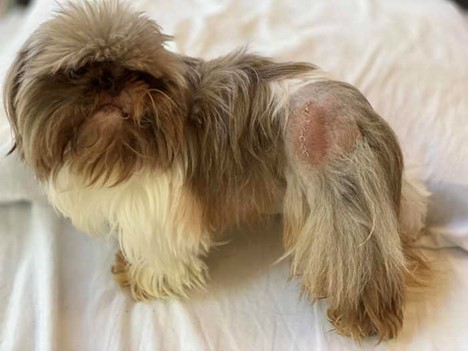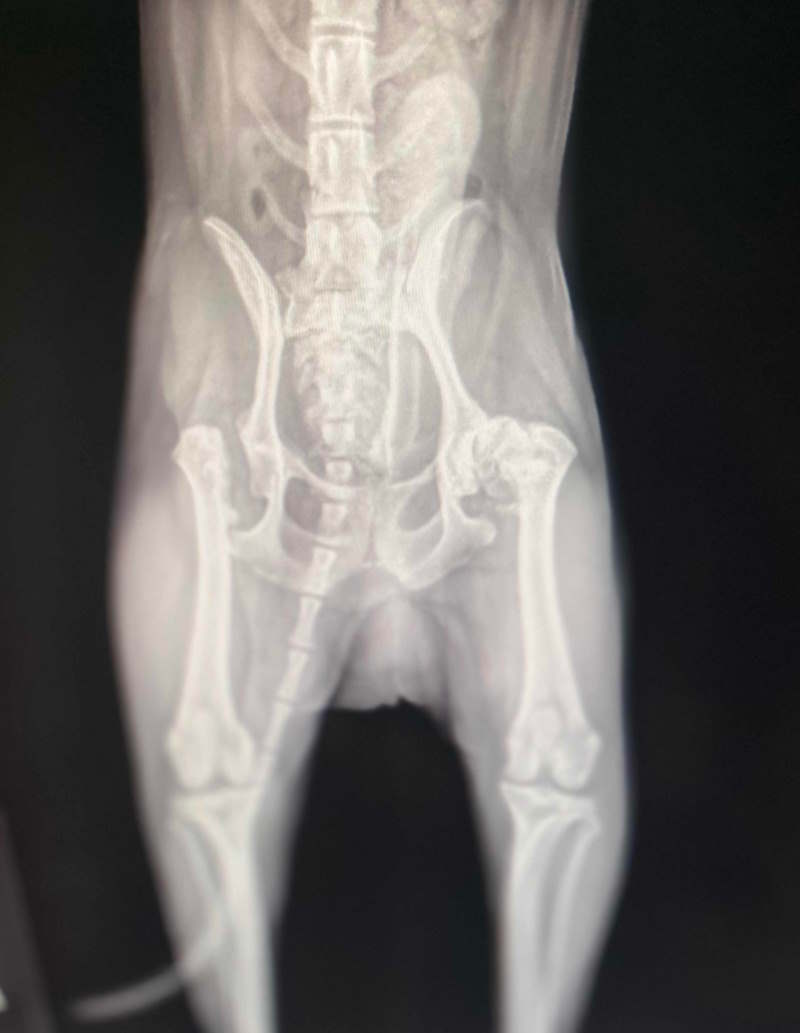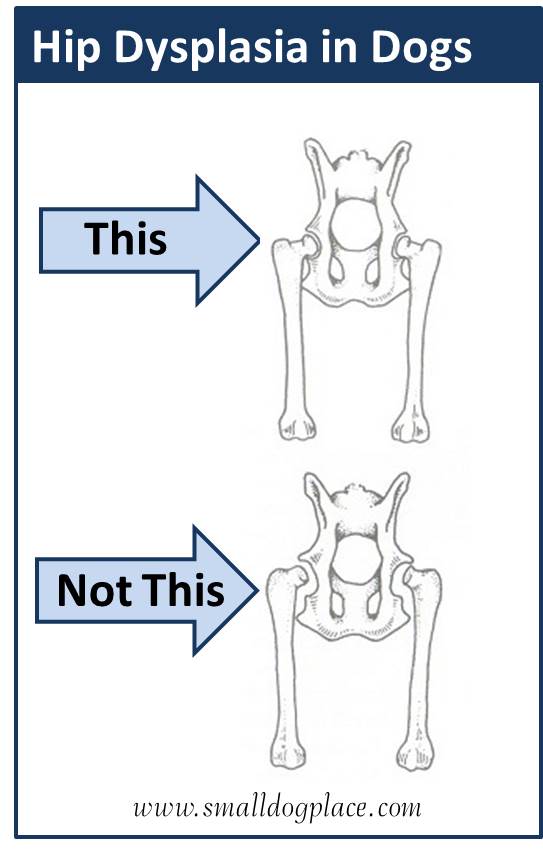- Small Dog Place Home
- Diseases
- Hip Dysplasia
What You Must Know
About
Hip Dysplasia in Small Dogs
Hip Dysplasia in Small Dogs: A Comprehensive Overview, by Janice Jones, Last Updated 04-25-2024
Hip dysplasia, an inherited skeletal ailment, is a prevalent disease in canine companions, usually manifesting as abnormal hip joint development.
This condition often results in substantial pain and compromised mobility, making it the most common cause of rear leg lameness in dogs.
While more typical in larger breed dogs such as German Shepherds, Labrador Retrievers, Golden Retrievers, Rottweilers, and Bullmastiffs, it also occurs in smaller breeds, even tiny dogs, as I will address in just a moment.
Understanding the Anatomy
A basic lesson in canine anatomy is critical to understanding hip dysplasia. The hip joint, in dogs and humans, is a ball-and-socket joint comprising the head of the femur, or large leg/thigh bone, and the acetabulum of the pelvis.
In normal dogs, the top of the leg bone or femur fits tightly into the hip socket of the pelvis.
There is a slick coating of cartilage providing a cushion to allow smooth movement. However, when a dog is afflicted with hip dysplasia, this socket is poorly developed and shallow, causing these movements to create abnormal friction.
This misshaped socket can lead to joint instability and abnormal wear and tear, causing inflammation, pain, and further joint damage.
Causes and Contributing Factors of Hip Dysplasia in Small Dogs
Hip dysplasia is primarily considered an inherited condition caused by a polygenic trait, meaning more than one pair of genes is involved.
Unfortunately, there are currently no genetic tests available to help predict this disorder. Alongside genetic susceptibility, several other factors contribute to the development of this disease.
Diet
Diet plays a vital role, particularly for puppies that may be predisposed to hip dysplasia. A high-calorie diet leads to rapid weight gain in puppies, which further stresses the hips and can exacerbate the problem.
An improper balance of calcium and phosphorus is detrimental to bone development. Obesity also plays a part as it increases the stress on the dog's hips.
Another contributing element to hip dysplasia skeletal disease in dogs is obesity or rapid weight gain during the crucial phases of puppyhood or adolescence.
Exercise
Exercise, especially during periods of rapid growth, can trigger the problem. Activities that involve jumping up and down, landing on the back legs, can put undue pressure on the hips, leading to the onset of hip dysplasia.
Affected Small Breed Dogs
As mentioned early, it is more common in large breed dogs, but it does occur in small breed dogs too. Breeds affected according to Orthopedic Foundation for Animals
They are listed in descending order according to OFA from Pugs being the most affected to Tibetan Terriers being least affected.
My Personal Experience with Hip Dysplasia in Small Dogs

I promised I would address hip dysplasia in tiny dogs. Please meet my tiny dog, Ketchikan, a purebred 4 pound Shih Tzu.
His hip x-rays were fine for the first 3 years of life and he was used in a breeding program. By the time he was 5, he was having pain issues even though he was on a high quality diet and a moderate amount of exercise.
He was never a jumper and we had to purchase dog stairs and a ramp for him to use because he loved sleeping in my bed.

He was eventually treated with a femoral head ostectomy which helped for a while, but by the time he reached 8 years old, he experienced pain again, this time on the other side of his body.
Again, he was diagnosed and underwent another femoral head ostectomy. At nine, he is doing fine even though he has had bilateraly femoral head ostectomies. Size doesn't discriminate against hip dysplasia.

Symptoms and Diagnosis
Early-stage hip dysplasia may not present with obvious symptoms. As degeneration occurs, changes in the dog's walk might be the first signs an owner notices.
The hind legs might wobble, or the dog may begin to limp, favoring one leg over another. Stiffness after sleeping, difficulty climbing steps, an unusual gait, and reduced activity levels can be signs of pain.
Signs of Pain in Dogs
- Dogs are less active
- Dogs have more trouble getting up and lying down
- Dogs have difficulty climbing steps
- Dogs have an unusual gate
A definitive diagnosis can only be achieved through an X-ray often conducted under sedation or anesthesia for better image quality.
The X-ray might show severe changes but not necessarily reflect the dog’s pain level since many dogs with severe dysplastic hips can still run, jump, and appear unperturbed by their condition.
Unfortunately, an X-ray cannot predict the level of pain a dog might be suffering. According OFA, there are many dogs suffering with severe dysplastic hips that run, jump and play as if nothing is wrong.
Then, there are dogs will little obvious changes on the X-ray that are lame, limping and in obvious pain.
The veterinarian will also want to evaluate how the dog walks and moves. Other conditions can cause limping and pain including lower back problems, cruciate ligament tears and elbow dysplasia.
Testing
There are currently no genetic tests that breeders can do on the mother and father to assure perspective puppy buyers that their dog will not get hip dysplasia.
There is a genetic component, but environmental factors also play a role in whether any one dog will develop hip dysplasia. There are, however, ways that breeders can begin to control the disease.
OFA Orthopedic Foundation for Animals maintains a database of radiographs for pure bred dogs. At two years of age, a breeder can submit X-rays taken by their veterinarian for evaluation.
The OFA certified radiologist will review the X-rays and certify the dog as Excellent, Good, or Fair and assign a number. This only allows the breeder to know what condition their breeding stock is in at the time of submission.
Treatment and Management
While there's no definitive cure, various strategies can manage hip dysplasia to maintain a dog's quality of life. A vet might recommend restricting the dog's activity and prescribing medication such as non-steroidal anti-inflammatories to relieve pain and inflammation.
Weight management is crucial, particularly for overweight dogs. A low-calorie diet and supplements like Glucosamine for joint repair can help. Suitable exercises include strength-building ones like swimming or walking on grassy areas. It's important to avoid high-impact activities, such as running or jumping.
Environmental modifications, like providing pressure-reducing orthopedic foam beds, ramps, and stairs for furniture access can ease daily life. Physical therapies like massage and hydrotherapy can reduce pain, with underwater treadmills often promoted at specialty veterinary hospitals.
In some cases, surgery may be recommended, especially for dogs that do not improve with medicinal treatment. Surgical techniques range from reshaping the joint to full hip replacement.
Prevention and Breeding Considerations
Preventing excess weight gain and monitoring puppy activities can reduce stress on their hips, crucial for those predisposed to hip dysplasia.
As this disease has a genetic component, breeders can influence control over this disease with data maintained by the Orthopedic Foundation for Animals, which certifies the condition of purebred dogs' hips based on submitted X-rays.
While caring for dogs with hip dysplasia requires dedication, providing the right level of care, mindful exercise, a suitable diet, regular check-ups, and potential medical treatments can significantly enhance their comfort and quality of life. Be sure to consult with your vet for a tailored care plan for your dog's needs.
Hip Dysplasia in Small Dogs Conclusion
In conclusion, hip dysplasia is a common and often painful condition for our canine companions. Understanding the causes, recognizing the symptoms, and knowing the treatment options are critical steps in managing this disease and providing our loyal friends the best quality of life possible.
While a definitive cure remains elusive, there are numerous methods we can employ to limit the risk and lessen the impact of this ailment on our dogs. An early diagnosis, targeted treatment strategies, carefully controlled exercise routines, and a balanced diet can notable difference for dogs living with hip dysplasia.
By implementing these proactive management strategies, we can ensure that our dogs, regardless of their size or breed, continue to lead active, joyful, and fulfilling lives.
About Janice (author and voice behind this site)
Having lived with dogs and cats most of her life, Janice served as a veterinary technician for ten years in Maryland and twelve years as a Shih Tzu dog breeder in Ohio.
Her education includes undergraduate degrees in Psychology with a minor in biology, Early Childhood Education, and Nursing, and a master's in Mental Health Counseling.
She is a lifelong learner, a dog lover, and passionate about the welfare of animals. Her favorite breed for over 50 years has been the Shih Tzu, but she has also lived with Poodles, Maltese, Yorkshire Terriers, Beagles, English Bulldogs, Carin Terriers, and a Cocker Spaniel.
When not writing, reading, and researching dog-related topics, she likes to spend time with her eight Shih Tzu dogs, husband, and family, as well as knitting and crocheting. She is also the voice behind Miracle Shih Tzu and Smart-Knit-Crocheting
Does This Article Deserve Your Thumbs Up?
We always appreciate your support and encouragement. Your thumbs up means so much to us. Please like this article.
If you find this page or any page on Small Dog Place Helpful, or useful in anyway, I'd love it if you would click the small heart found on the bottom right of each page.
You can also share or bookmark this page -- just click on the:

Free Monthly Newsletter
Sign Up for Our Free Newsletter and get our Free Gift to You.
my E-book, The Top 10 Mistakes People Make When Choosing a Dog (and how to avoid them)



